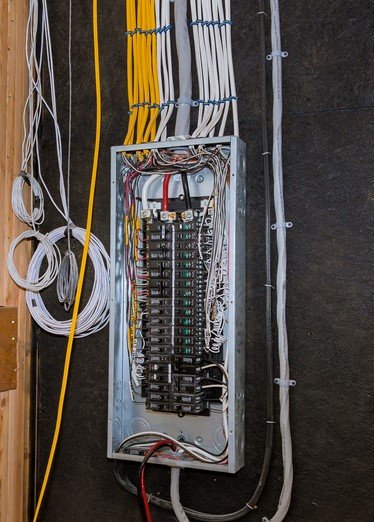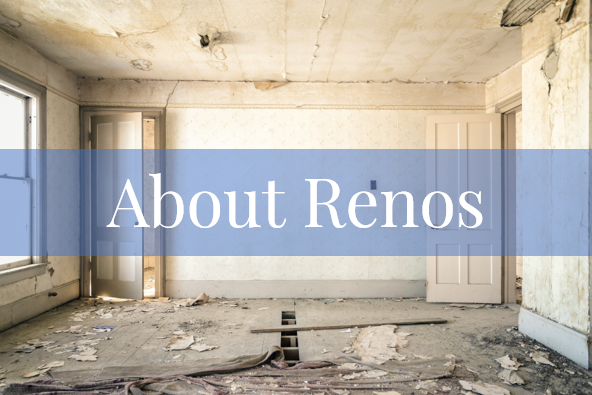Reasons Why Your Circuit Breakers Might Be Tripping and What You Should Do About It
/You're finally sitting and relaxing, enjoying that movie you've been looking forward to all night. Your daughter is upstairs getting ready to go out, and she turns the hair dryer on. Boom! The breaker trips, and the power is out in your living room and part of the second floor. Sure, you can go and reset the breaker every time it trips, but maybe it's time to figure out why it keeps tripping and what you should do about it. In this post, we'll talk about electrical safety and let you know why your breaker might be tripping and how to fix it.
Please note that we are not Electrical Safety Authority inspectors. Multi-Trade Building Services is a Licensed Electrical Contractor registered with the Electrical Safety Authority. The information in this blog post comes from our 30+ years of experience in the electrical industry. However, if you have any questions regarding any electrical issues in your home, you must contact your local Electrical Safety Authority. We are not authorized to specifically answer electrical questions related to your home. The information here in this blog post is merely designed to be informative and to help you maintain safety in your home.
Prefer to listen?
What Is a Circuit Breaker?
Your circuit breakers are located in your electrical panel, and they control the flow of electricity through all items on their circuit. They are designed to trip anytime the flow of electricity is too high or unsafe.
There are a few different types of circuit breakers, and the number of items on each one will differ according to what is connected to it. For example, your fridge should always be on a dedicated circuit. That means that an electrical cable will run from the receptacle that your fridge is plugged into all the way back to the panel and into one circuit breaker. Nothing else should be connected to that circuit breaker.
Other circuit breakers might control up to 12 items. For example, light fixtures and receptacles that, by code, do not need to be dedicated can be one of the 12 on a circuit breaker. Certain receptacles, like the fridge receptacle I talked about before, need to be dedicated. All the receptacles that need to be dedicated include, but are not limited to, kitchen counter receptacles, microwave receptacles, and your washing machine. For a more detailed explanation of the electrical safety code in your home, please refer to our blog post, A Guide to Ontario Electrical Code in Your Home.
Other types of circuit breakers include arc-fault circuit interrupters (AFCI) and ground-fault circuit interrupters (GFCI). AFCIs are designed to protect your home from dangerous arcing faults. GFCIs are usually installed to protect circuits where there is close contact with water. When water gets into the receptacle, the GFCI breaker will trip.
Circuit breakers also come in different sizes. The most common-sized circuit breaker is a single-pole 15-amp breaker, which will control most of the devices in your home. Some appliances, such as your stove, require a double pole 40-amp breaker. Your dryer should be connected to a double-pole, 30-amp breaker. Each appliance, including your air conditioner, will have specifications indicating what size breaker and what size cable should be connected to it.
Although it can be extremely annoying when your circuit breakers trip, this is a necessary safety feature in your home. They are designed to trip anytime an unsafe situation occurs. However, if your breakers continue to trip, this is its own safety hazard and needs to be inspected and repaired by a Licensed Electrical Contractor.
How to Tell If a Circuit Breaker Has Tripped
Sometimes it's obvious that a circuit breaker has tripped when all of a sudden lights or TVs turn off in a room. However, it can also be very subtle. You will go into a room and plug something in, and suddenly the receptacle isn't working. At first, you may not think anything of it and just believe the receptacle to be defective. Several days later, you'll go to turn the light on in another room, and it doesn't work. Your first thought is to change the lightbulb, which, of course, hasn't fixed the problem. This could be a circuit breaker that has tripped.
Go to your electrical panel and open the door on your panel. All the switches on your breakers should be facing the same way, assuming that none of the breakers were deliberately turned off previously. A tripped breaker will usually have the switch facing the opposite direction. Sometimes the switch gets stuck in the middle. This is also a tripped breaker.
Another point to note here is a common problem I see in many of my clients' homes. Access to the electrical panel is often blocked. The electrical panel is usually in a corner of the basement in most homes. Occasionally, it can also be in the garage. These are both places where stuff tends to get stored. So often, we see lots of things piled up in front of the electrical panel. It is actually an Electrical Safety Authority code violation to have anything within one meter of your electrical panel. This is designed for safety to ensure that in the event of an electrical emergency where an electrician needs to get to that panel quickly or even you, as the homeowner, need to get there to turn a breaker off, nothing will be in your way and you'll be able to address any emergency in a safe and timely fashion. Take a moment right now and go down to your electrical panel to ensure that first, you know exactly where it's located, and second, you have one meter of clearance in front of that electrical panel to get to it should an emergency occur.
It's also critical to ensure that your electrical panel is thoroughly and accurately labelled. If you see smoke coming from a receptacle in your living room, you're going to want to know exactly which breaker controls that receptacle so that you can get to your panel quickly and turn that breaker off. If you don't know which breaker controls what in your electrical panel, you could waste precious moments trying to figure that out. For a free step-by-step, downloadable, and printable guide on how to label your electrical panel, click the button below.
Did a Monkey Wire Up My House?
One of the most common things I hear from my clients is, "Why aren't all the switches and lights from all my bedrooms all on one circuit?"
Although initially it might make sense to wire up a house in that manner, it's actually designed differently with a purpose in mind. Most often, a few receptacles in the living room, a couple receptacles in the dining room, and a light or two in the kitchen will all be on one circuit. Then the second circuit will pick up the other receptacles in the dining room and living room, and possibly one of the lights in the kitchen. This is done in that manner because if one of those breakers trips, there will still be power in each of those rooms, which means you would be able to have lights and power to see in those rooms.
How to Reset a Tripped Breaker
The simplest way to reset a tripped breaker is to push it all the way back to the 'off' position and then push it to the 'on' position. Do this firmly but not aggressively. For safety, ensure that you step back from the panel and off to the side if there is space. If you have a pair of safety goggles, it's a good idea to put them on. At this point, it's unlikely that you know what caused the breaker to trip in the first place, so just in case any sparks start to fly, you need to protect yourself.
We recommend that you keep a flashlight near the electrical panel. If the breaker that has tripped has caused the lights to go out in the basement where the panel is, you will need to ensure that you have good light at the panel before you start touching the breakers.
So Why Did My Breaker Trip?
The most common reason a breaker will trip is due to an overloaded circuit. An overloaded circuit occurs when more electricity passes through the breaker than it is intended to carry.
This can happen when electrical work is done in the home by a non-licensed handyman. We've even seen homeowners who have watched YouTube videos and feel they know how to install pot lights in their living room or add extra receptacles in their workshop. Instead of running cables back to the panel that may be required in a dedicated circuit breaker, they will just put junction boxes in the ceiling and connect wires to existing circuits. If a circuit was already overloaded or that circuit happened to be a dedicated breaker, this can cause a circuit breaker to overload.
You will sometimes see what's called double tapping in an electrical panel as well. Only one electrical cable should ever be connected to each breaker. When we are doing home inspections, it's not uncommon for us to see two wires connected to one breaker. This is double tapping. This is a safety hazard and will almost always cause overloaded circuits.
Breakers will also trip on a short circuit. This will occur when an active or hot wire touches a neutral wire. When the two touch, a large amount of current flows and overloads the circuit. When this happens, a breaker will trip or a fuse will blow. This is a safety feature to protect your home from the potential of fire. When a short circuit occurs, you may also see sparks, hear popping sounds, or smell smoke.
Short circuits can occur when there are loose or corroded wires, damage to wires because of animals chewing on them, such as mice in the attic, or even from a faulty receptacle, switch, or light fixture. A short circuit can also occur if a nail or screw is accidentally driven through a cable.
Short circuits are a serious safety issue as a large amount of heat can be created from them. This is nothing to fool around with, and a licensed professional should be called in to investigate and repair it.
What Do I Do Now?
I'm all for DIY, but not when it comes to electrical work. If you're having electrical issues in your home, don't ignore them or try to fix them yourself. This is the time to pay for a professional to have a look, figure out what is causing the tripping circuit, and get it fixed.
I don't know how many times clients have called us in to assess the problem; they find out that their circuits are overloaded, and then they find out what it's going to cost to run the proper wires and reduce the load on the breakers. Far too often I get told, "Oh, the breakers don't trip that often. I'll just live with it." Recently, a client who said that called me back two months later and showed us the receptacle that was black from the smoke that was coming out of it before she shut the breaker off. She then decided it was in her best interest to have the electrical issue fixed.
We have done many electrical inspections for our clients over the years. Many of our clients will call us every five years to do a quick inspection of their electrical system. This ensures that everything is safe and that nothing needs to be addressed, repaired, or dealt with. This is an excellent Home Maintenance project to plan for every five years. It will ensure the safety of you, your family, and your home.
If you are interested in booking us to complete an electrical inspection in your home and you live within the Durham Region area in Ontario, give us a call at 905-259-3344. Your peace of mind and the safety of your family are worth it!

















